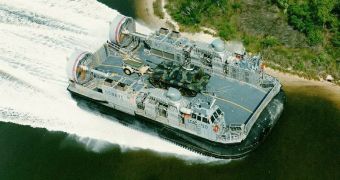The hovercraft (to hover - to remain floating, suspended, or fluttering in the air; craft - vessel or vehicle) is an amphibious military or civilian vehicle designed to travel over any kind of surface (as long as it's reasonably flat), being supported by a cushion of pressurized air.
It may look weird and some of them may look like floating UFOs, but they rely on physics and control equipment, float on a volume air at a low pressure, ejected downwards against the surface close below it.
It is actually more closely related to aircrafts than it is to boats or automobiles and it is also called an Air Cushion Vehicle (ACV).
They are the latest development in the ACVs family, supported by pressurized air. In has been invented in 1952 by the British inventor Christopher Cockerell, although there have been some previous attempts to build vehicles based on the "ground effect" principle (the idea that trapping air between a fast moving vehicle and the ground can give extra lift and reduce drag), but with limited or no success.
Just like the MagLev, magnetic levitation train, it hovers in the air on a cushion of air that greatly reduces drag, and thus, less friction means less energy required to propel it. Unlike the magnetic trains, it doesn't use magnetic forces to defy gravity and friction, but rather mechanical forces, in this case, the pressure generated by a powerful jet of air.
Most of them use at least two engines, both connected to large fans, like the propeller of the aircrafts.
One is used to create the vertical airflow and it's a blower fan responsible for lifting the vehicle by forcing air under the craft. The air therefore must exit throughout the "skirt", lifting the craft above the area on which the craft resides.
The other engines are used to provide the thrust and to horizontally steer the craft and can either have airplane-like flaps to direct the air or they can move themselves in order to change the direction.
There are some hovercrafts that use ducting to allow one engine to perform both tasks by directing some of the air to the skirt, the rest of the air passing out of the back to push the craft forward.
The "skirt" of the craft is the region of trapped air underneath the hovercraft called a "plenum chamber," and it's tightly sealed, so that the air doesn't just come out under the boat in all directions, which lose the lifting effect, but in a controlled manner, to create a ring of circulating air and since more air is being forced into the plenum chamber at all time, the air underneath the craft is at a higher pressure than the air outside the chamber.
It's in fact a unique propulsion through a combination of lift and thrust.
Steering is in fact the most difficult part of controlling a hovercraft, since only the edges of the skirt touch the ground and like an unskilled skater on ice, it too has the tendency to go in whatever direction it is pushed, regardless of the fact that it may not be the desired one.
Slowing down and stopping are challenging too, but there some advantages that have made the early prototype a fully working model.
For instance, you can make a 180 degrees turn, travel backwards, using the fan to counteract the vehicles momentum and it can go over water, snow, ice, concrete, dirt, grass and generally over any reasonably smooth surface.
It's these qualities that made it the favourite transport craft of the military and many civilian companies all over the world and if you can get past the noise and the tight turns, it can actually be a thrilling experience to drive one.

 14 DAY TRIAL //
14 DAY TRIAL //